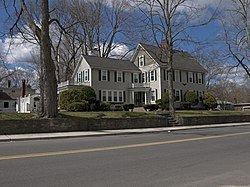County Windham Incorporated 1708 Population 17,386 (2005) | Elevation 137 m Local time Monday 5:16 PM | |
 | ||
Region Northeastern Connecticut Weather 1°C, Wind S at 11 km/h, 29% Humidity University Quinebaug Valley Community College | ||
Killingly is a town in Windham County, Connecticut, United States. The population was 17,370 at the 2010 census. It consists of the borough of Danielson and the villages of Attawaugan, Ballouville, Dayville, East Killingly, Rogers, and South Killingly.
Contents
- Map of Killingly CT USA
- Geography
- Principal communities
- On the National Register of Historic Places
- Demographics
- Transportation
- Notable people
- References
Map of Killingly, CT, USA
Geography
According to the United States Census Bureau, the town has a total area of 50.0 square miles (129 km2), of which, 48.5 square miles (126 km2) of it is land and 1.5 square miles (3.9 km2) of it (2.94%) is water.
Principal communities
On the National Register of Historic Places
Demographics
As of the census of 2010, there were 17,370 people, 6,749 households, and 4,528 families residing in the town. The population density was 358.1 people per square mile (137.9/km²). There were 7,592 housing units at an average density of 156.5 per square mile (60.3/km²). The racial makeup of the town was 93.1% White, 1.5% African American, 0.4% Native American, 1.8% Asian, 0.7% from other races, and 2.4% from two or more races. Hispanic or Latino of any race were 3.0% of the population.
The borough of Danielson, as well as the town of Killingly, is also home to a small but significant Laotian community. Both Danielson and Killingly are on the nation's list of top 50 cities with the highest percentage of citizens claiming Laotian ancestry.
Of the 6,749 households: 29.2% had children under the age of 18 living with them, 47.8% were married couples living together, 13.2% had a female householder with no husband present, and 32.9% were non-families. 25.1% of all households were made up of individuals and 9.9% had someone living alone who was 65 years of age or older. The average household size was 2.52 and the average family size was 2.98.
In the town, the population was spread out with 22.4% under the age of 18, 8.2% from 18 to 24, 27.0% from 25 to 44, 28.5% from 45 to 64, and 13.9% who were 65 years of age or older. The median age was 40 years. For every 100 females there were 97.4 males. For every 100 females age 18 and over, there were 94.7 males.
The median income for a household in the town was $55,598, and the median income for a family was $68,565. Males had a median income of $49,467 versus $35,429 for females. The per capita income for the town was $26,585. About 8.5% of families and 10.3% of the population were below the poverty line, including 12.7% of those under age 18 and 6.1% of those age 65 or over.
Transportation
Danielson Airport is a state owned, public use airport located two nautical miles (4 km) northwest of the central business district of Danielson, a borough in Killingly.
